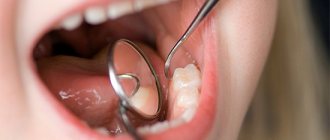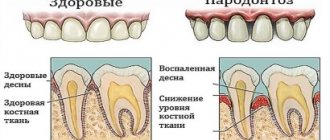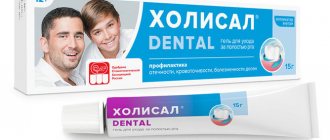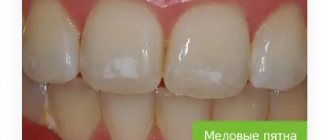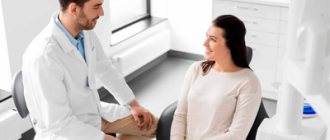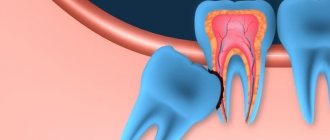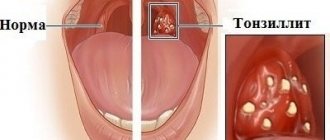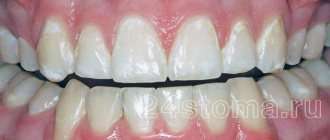Periodontal disease is a chronic disease of the oral tissues that is non-inflammatory in nature. The disease affects the gums, periodontal areas, alveolar processes; characterized by gradual tissue atrophy, which leads to changes in the hard areas of the teeth and exposure of the dental necks.
The difference between periodontal disease and periodontitis is the absence of an inflammatory process. In the first case, inflammation does not develop in the oral cavity, but is present in advanced forms of the disease, when the patient’s immunity is weakened.
Signs of periodontal disease
The disease has an asymptomatic period of development, the symptoms become pronounced after the transition to moderate severity, when the periodontal tissues become very thin. Visual detection of symptoms is complicated by the presence of tartar, which hides the necks of the teeth and does not allow assessing their condition. A diagnosis can only be made after professional cleaning by a dentist.
The number and severity of symptoms depend on the stage. Signs of the disease include:
- exposure of tooth roots;
- the appearance of a pale tint in the gum tissue;
- increased sensitivity of the patient’s teeth to cold and hot foods;
- darkening of tooth enamel;
- development of sclerotic changes in bone tissue;
- the appearance of gaps between teeth;
- discomfort and itching in the gum area;
- loss of stability, loosening of teeth.
Inflammation and bleeding of the gums during periodontal disease are rare and are present in advanced stages of the disease.
To make a diagnosis, the dentist prescribes an x-ray examination, which allows you to determine the presence of sclerosis of bone tissue, the degree of development of gum atrophy and identify foci of osteoporosis.
Ointments for gum inflammation
According to statistics and reviews, the best ointments
that help get rid of periodontal disease are:
- Traumeel S is a homeopathic remedy that contains only mineral and herbal components. It has a good effect only in the early stages of the disease. The action of Traumeel S is aimed at relieving inflammation, restoring the density of vessel walls and improving their conductivity.
- Heparin ointment is an anticoagulant. With its help, they eliminate inflammatory processes and strengthen the gums. Heparin significantly reduces the level of platelet aggregation and restores tissue microcirculation.
Since ointments have a fatty base, they practically do not stick to the gums. Therefore, it is recommended to use them as applications. To do this, the product is applied to a cotton swab, which is fixed on the inflamed area using a special film or bandage. As a result, the therapeutic effect of the drug will last for a long time.
Stages of periodontal disease
Periodontal disease can be acute or chronic. Depending on the degree of spread of the pathology, there are the following types of disease:
- localized - the necks of the teeth are exposed in a separate area;
- generalized - pathological processes develop throughout the dentition.
Periodontal disease develops over several years; depending on the patient’s condition, the disease is divided into stages:
- Early - the presence of initial changes in tissues, which can be determined by the dentist during examination;
- The first is increased sensitivity of teeth to hot and cold foods, receding gums;
- The second is pronounced exposure of the dental necks, sensitivity, the formation of gaps between the teeth and the appearance of dental cement instead of enamel;
- The third is severe receding gums, gradual loosening of teeth;
- The fourth is the advanced stage: the teeth become very loose, making it difficult to eat. At this stage, tooth loss occurs.
Treatment
The treatment procedure depends on the stage of the disease and includes the following steps:
- Diagnostics at the dentist, making a diagnosis and taking an x-ray of the jaw;
- In-office dental cleaning to remove hard deposits, antibacterial therapy of the oral cavity;
- Orthopedic treatment of loose teeth to strengthen them. Splinting and prosthetic techniques are used to reduce the load on damaged teeth;
- Physiotherapeutic treatment - procedures to restore blood circulation to the gums and prevent relapses of the disease;
- Gum tissue augmentation is carried out when the necks of the teeth are severely exposed.
Self-treatment is impossible. Home remedies are not able to get rid of the causes of the disease. If you notice the first symptoms, contact your dentist.
Treatment with antibiotics, dental ointments and gels
Drug therapy is possible after professional teeth cleaning as prescribed by a doctor. Antibiotics should be taken in recommended doses in the absence of inflammatory processes in the oral cavity.
In some cases, during treatment, injections are prescribed simultaneously with the drugs Traumeel and Lincomycin.
To relieve symptoms, the dentist prescribes gels and ointments:
- "Metrogil Denta" is an anti-inflammatory, analgesic agent;
- "Cholisal" - a gel to combat gum inflammation;
- "Kamistad" - for the prevention of gingivitis, relieving swelling, eliminating pain;
- “Gengigel” is a gel that increases blood circulation and promotes the regeneration of soft tissues;
- "Stomatofit" - to relieve severe pain;
- "Asepta" - to stimulate tissue regeneration processes;
- "Solcoseryl" is an antiseptic with a healing effect.
What ointment should I use to relieve itching of gums due to periodontal disease?
One of the symptoms of periodontal disease is itchy gums. To remove it, dentists advise using the drug Asept.
Due to two active components - chlorhexidine and metronidazole, the gel also has a disinfecting and antimicrobial effect, killing various kinds of pathogenic microbes. It contains many vitamins and ubiquinone, which is involved in energy production and is an antioxidant.
Thanks to the sticky base, Asepta adheres well and remains on the gum for a long time, providing a calming effect and removing the source of inflammation.
In the treatment of periodontal disease, by prescribing Asepta, dentists achieve relief from pain, decreased sensitivity of enamel, increased elasticity and density of gum blood vessels, elimination of swelling and itching.
Is it possible to cure periodontal disease forever?
Treatment of the disease is carried out comprehensively with the involvement of specialists in the field of dentistry, immunology, endocrinology, gastroenterology, and therapy. The essence of treatment is to eliminate symptoms, strengthen teeth and prevent relapses. Additionally, restoration of lost tissue is carried out.
It is problematic to cure periodontal disease in the last stage, but contacting competent doctors will help get rid of unpleasant sensations and stop the further development of the disease, preserving your teeth.
Splinting
A treatment method used to strengthen loose teeth. Splinting involves combining individual teeth into a single orthopedic structure in the form of a block to reduce their mobility.
Prosthetics
Prosthetics for periodontal disease are carried out in combination with other treatment methods; it is possible to install several types of dentures, depending on the condition of the gums. Removable prosthetics helps reduce the load on areas affected by periodontal disease: installing clasp, nylon dentures that do not rub the mucous membranes and have a fastening system that does not damage the supporting teeth.
In some cases, permanent bridge structures are used to strengthen a number of teeth located one behind the other.
Prosthetics does not eliminate the cause of the disease. Without an integrated approach, tissue reduction will continue, and after 3-5 years the patient will need replacement prostheses.
How to treat periodontal disease -
If you have been diagnosed with periodontal disease, the symptoms and treatment will be interrelated, etc. This disease is based on the phenomena of vascular sclerosis and bone tissue degeneration - the main methods of treatment will be physiotherapy and drug therapy, aimed primarily at stimulating blood circulation in the gums. In addition, selective grinding of the contacts between the lower and upper teeth is carried out, and at the first symptoms of mobility, teeth are splinted with crowns or fiberglass.
Treatment of periodontal disease at home is limited only to the use of finger massage of the gums, the use of special gels for the gums and toothpastes, as well as the ingestion of various vitamins, antioxidants and some other drugs (we will discuss them below). All other treatment will involve professional dental care in a physiotherapy office.
Finger massage of gums –
Finger massage of the gums for periodontal disease is carried out every day, in the morning after brushing your teeth. The direction of movement of the fingers should coincide with the direction of lymph flow in this area, i.e. you should make circular massaging movements, which should gradually move from the front teeth - towards the chewing teeth. The procedure time is 3-5 minutes for each jaw. In addition to this massage, you can periodically (several times a year) conduct physiotherapy courses.
The massage can be done without everything, or using one of the special gels that additionally stimulate blood circulation in the gums. For example, this could be the drug Asepta in the form of a gel, which contains propolis (a beekeeping product). This gel can also be used without massage, simply applying it to the gum margin after brushing your teeth in the morning and evening. However, it should be noted that you will not be able to cure periodontal disease at home only with finger massage and gum gel.
An important point is that gum massage cannot be performed against the background of gum inflammation (with swelling, redness or severe cyanosis of the gums, as well as in the presence of deep periodontal pockets and subgingival dental plaque). Otherwise, an intensification of the inflammatory reaction and the development of purulent abscesses in the projection of periodontal pockets is possible.
Physiotherapy for periodontal disease –
There is a large list of physiotherapeutic methods for treating gum periodontal disease - these are electrophoresis, phonophoresis, vacuum massage, vibration vacuum massage, magnetic therapy, diadynamic currents, laser therapy. The problem is that not even every dental clinic has its own physiotherapy department, and residents of large cities are luckier here (especially where there are university dental clinics at medical universities).
For example, in Moscow there is a large department of physiotherapy for periodontal diseases at the state clinic TsNIIS (Central Research Institute of Dentistry). You can get a referral for physical therapy from your dentist. Next, we will talk in detail about some of the main physiotherapeutic techniques that are used for periodontal disease...
- Electrophoresis and phonophoresis of heparin - heparin has a significant therapeutic effect in periodontal disease, because
it has the ability to reduce tissue hypoxia, normalizing the oxygen balance of tissues, microcirculation and transport of substances between blood and tissues. Heparin electrophoresis is carried out according to the usual method: make gauze pads from a sterile bandage under each electrode, soak each pad - first with 1.0 ml of distilled water, then from a syringe - 1 ml of heparin solution. The concentration of heparin in 1.0 ml of solution should be 5000 units. Electrodes with gauze pads are placed on the gingival edge of the alveolar process of the jaws, while the electrodes are carefully isolated from saliva with cotton rolls. Heparin is always administered from the cathode only. The duration of the procedure is from 12 to 15 minutes. The course of treatment is 10-12 procedures (in a row, daily). In addition, heparin can be successfully introduced into periodontal tissue not only by electrophoresis, but also using the phonophoresis technique on the Ultrasound T-5 apparatus. The duration of the phonophoresis procedure is about 7-10 minutes.
- Vacuum massage - this method is tens and hundreds of times more effective than regular gum massage, which you can do at home.
Vacuum massage is carried out using a special Kulazhenko vacuum apparatus or similar devices in a physiotherapy room. This massage leads to the destruction of part of the capillaries, which is accompanied by the release of histamine, which tends to stimulate blood circulation. Even more effective is the creation of vacuum hematomas along the transitional fold during vacuum massage of the gums. For this, the pressure is set to 1 atmosphere, and the nozzle of the device must be held in one place for 30 to 60 seconds - until a hematoma of 4-5 mm in size is formed. During one visit, you can do no more than 5-6 such hematomas (a full course - 8-12 procedures, with breaks between procedures - 3-5 days). This method further stimulates metabolic processes and blood supply to the gums.
- The use of a laser - the use of a helium-neon laser for periodontal disease is aimed at enhancing tissue trophism, metabolic processes, and blood circulation. The course of treatment is usually 12-15 sessions, and is carried out several times a year. A single laser exposure should not exceed 20 minutes.
Drug therapy for periodontal disease –
There are several groups of drugs that can be effective in increasing blood circulation and reducing hypoxia in periodontal tissues.
These may be antioxidants, anabolic steroids, the use of certain vascular drugs that stimulate peripheral circulation. 1) The use of antioxidants - clinical studies have shown that sclerosis of blood vessels in periodontal tissues leads to a significant decrease in oxygen delivery to the gums and the development of hypoxia, which triggers the process of sclerosis of bone tissue. Therefore, a number of drugs to stimulate oxygenation can be very useful. These drugs include substances with antioxidant properties. First of all, this can be vitamin E, as well as vitamins A, C, P and group B.
2) The use of anabolic steroids - the use of this group of drugs is justified primarily in men, because drugs have an androgenic effect. In women, this may result in a deepening of the voice and menstrual irregularities, which disappears only with discontinuation of the drug. In addition, the prescription of this group of drugs should always be preceded by a consultation with a therapist and endocrinologist regarding the absence of contraindications. The drug "Retabolil" is prescribed at a dose of 25-30 mg IM, only once every 3 weeks (the full course of treatment is about 5-7 injections).
3) The use of Trental - the possibilities of increasing blood circulation in periodontal tissues are limited by the limits of the ability of blood vessels to expand, and with significant sclerotic changes in blood vessels in periodontal tissues - physiotherapeutic effects on the gums alone are no longer enough. In this regard, in case of moderate to severe periodontal disease, it also makes sense to prescribe drugs for the treatment of blood microcirculation disorders.
For these purposes, the drug Trental can be used. This drug contains pentoxifylline, which increases the concentration of amino monophosphate in the smooth muscle of the vascular wall (by inhibiting the enzyme phosphodiesterase). An increase in the concentration of amino monophosphate in the membranes of smooth muscle cells helps to reduce the contraction of the smooth muscles of the vascular wall, thereby increasing the lumen of the capillaries.
Trental also affects the rheological properties of blood - in particular, it increases the elasticity of red blood cells. Blood capillaries in the area of interdental gingival papillae and periodontal tissue have a very small lumen, and therefore disturbances in the elasticity of red blood cells can lead to disruption of tissue trophism (i.e., their saturation with oxygen and nutrients). In addition, trental additionally inhibits erythrocyte aggregation, thereby preventing microvascular thrombosis, which is often observed in periodontal disease.
Prescription regimens: the drug is prescribed 2 tablets of 100 mg each - 3 times a day (16 days in total), after which the drug is taken 1 tablet of 100 mg - 3 times a day for another 1 month. However, the combined use of trental is even more effective. The combination includes a course of administering trental by electrophoresis (from the cathode) or by phonophoresis + oral administration of the drug according to the scheme indicated above.
Selective grinding of teeth –
When treating periodontal disease, it is very important to take into account that in such patients there is an excess of calcium in the hard tissues of the teeth, which leads to a delay in the physiological wear of the teeth. This would seem good, but in fact it leads to the formation of a traumatic bite in the area of the front teeth and their gradual fan-shaped divergence. Therefore, it is very important to send the patient to an orthopedic dentist for selective teeth grinding - in order to normalize the contacts between the upper and lower teeth.
In addition, delayed abrasion of the cusps on the chewing surfaces of the teeth, leading to the development of a traumatic bite in the area of the anterior teeth, can cause not only their fan-shaped divergence, but also the formation of a large number of wedge-shaped dental defects.
Splinting of mobile teeth –
The procedure for splinting teeth can be performed with fiberglass or artificial crowns, the need to choose between which will be dictated by the clinical situation in the oral cavity. Indications for the use of this method will be the emerging mobility of teeth, or their fan-shaped divergence (consisting in the displacement of teeth and an increase in interdental spaces). Read more about this method using the link above.
Use of toothpastes and gels –
Toothpastes and rinses from the Mexidol-Dent series are especially suitable for increasing blood circulation in the gums. They contain an antioxidant that helps reduce the level of hypoxia in periodontal tissues, which inevitably occurs due to hardening of blood vessels during periodontal disease. Toothpastes based on propolis can also have a stimulating effect on the blood supply to the gums (24stoma.ru).
Question answer
Is periodontal disease inherited?
Yes, this is a chronic disease that can be inherited and be asymptomatic, destroying tissue, but without causing discomfort to the patient.
Is periodontal disease transmitted through kissing?
No, this is not a contagious disease that cannot be contracted through airborne droplets, through shared utensils, kissing, etc. This is a systemic disease that causes disruption of internal organs and is not transmitted from person to person.
Should teeth be removed if there is periodontal disease?
When the disease reaches an advanced stage, the dentist prescribes treatment in the form of strengthening the gums, building tissue, stimulating regeneration and blood circulation. Removal is carried out in the absence of alternative treatment methods.
Is there bad breath?
Yes, when interdental spaces appear, food particles get into them, which serve as a breeding ground for the development of bacteria that cause an unpleasant odor.
